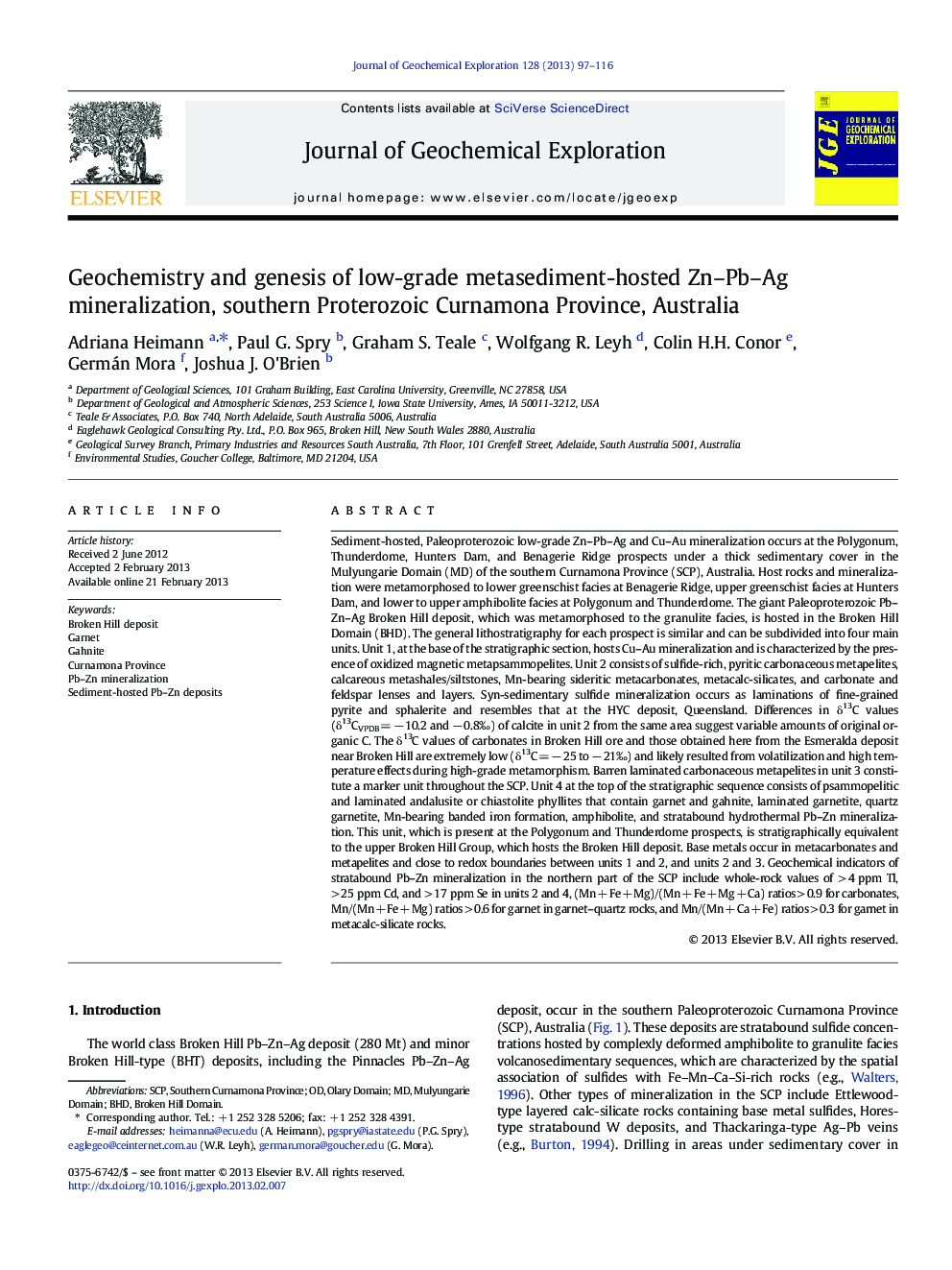| کد مقاله | کد نشریه | سال انتشار | مقاله انگلیسی | نسخه تمام متن |
|---|---|---|---|---|
| 4457632 | 1620929 | 2013 | 20 صفحه PDF | دانلود رایگان |

Sediment-hosted, Paleoproterozoic low-grade Zn–Pb–Ag and Cu–Au mineralization occurs at the Polygonum, Thunderdome, Hunters Dam, and Benagerie Ridge prospects under a thick sedimentary cover in the Mulyungarie Domain (MD) of the southern Curnamona Province (SCP), Australia. Host rocks and mineralization were metamorphosed to lower greenschist facies at Benagerie Ridge, upper greenschist facies at Hunters Dam, and lower to upper amphibolite facies at Polygonum and Thunderdome. The giant Paleoproterozoic Pb–Zn–Ag Broken Hill deposit, which was metamorphosed to the granulite facies, is hosted in the Broken Hill Domain (BHD). The general lithostratigraphy for each prospect is similar and can be subdivided into four main units. Unit 1, at the base of the stratigraphic section, hosts Cu–Au mineralization and is characterized by the presence of oxidized magnetic metapsammopelites. Unit 2 consists of sulfide-rich, pyritic carbonaceous metapelites, calcareous metashales/siltstones, Mn-bearing sideritic metacarbonates, metacalc-silicates, and carbonate and feldspar lenses and layers. Syn-sedimentary sulfide mineralization occurs as laminations of fine-grained pyrite and sphalerite and resembles that at the HYC deposit, Queensland. Differences in δ13C values (δ13CVPDB = − 10.2 and − 0.8‰) of calcite in unit 2 from the same area suggest variable amounts of original organic C. The δ13C values of carbonates in Broken Hill ore and those obtained here from the Esmeralda deposit near Broken Hill are extremely low (δ13C = − 25 to − 21‰) and likely resulted from volatilization and high temperature effects during high-grade metamorphism. Barren laminated carbonaceous metapelites in unit 3 constitute a marker unit throughout the SCP. Unit 4 at the top of the stratigraphic sequence consists of psammopelitic and laminated andalusite or chiastolite phyllites that contain garnet and gahnite, laminated garnetite, quartz garnetite, Mn-bearing banded iron formation, amphibolite, and stratabound hydrothermal Pb–Zn mineralization. This unit, which is present at the Polygonum and Thunderdome prospects, is stratigraphically equivalent to the upper Broken Hill Group, which hosts the Broken Hill deposit. Base metals occur in metacarbonates and metapelites and close to redox boundaries between units 1 and 2, and units 2 and 3. Geochemical indicators of stratabound Pb–Zn mineralization in the northern part of the SCP include whole-rock values of > 4 ppm Tl, > 25 ppm Cd, and > 17 ppm Se in units 2 and 4, (Mn + Fe + Mg)/(Mn + Fe + Mg + Ca) ratios > 0.9 for carbonates, Mn/(Mn + Fe + Mg) ratios > 0.6 for garnet in garnet–quartz rocks, and Mn/(Mn + Ca + Fe) ratios > 0.3 for garnet in metacalc-silicate rocks.
► Pb–Zn mineralization, Curnamona Province, Australia, is syngenetic/early diagenetic.
► The stratigraphy, hosting ~ a billion tons of Pb–Zn mineralization, was re-defined.
► Rocks and Pb–Zn mineralization are similar to that at the giant Broken Hill deposit.
► Geochemistry indicates a link between biogenic C-mineralization–carbonate genesis.
► Chemical exploration tools in the search for Broken Hill-type deposits are provided.
Journal: Journal of Geochemical Exploration - Volume 128, May 2013, Pages 97–116